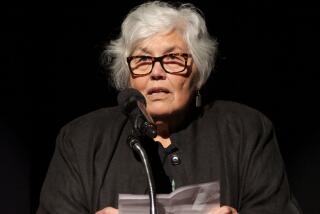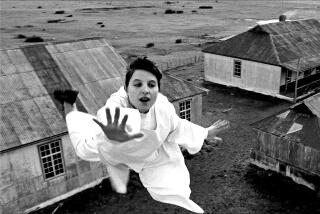Carlos Reygadas’ films search for authenticity beyond reality
Two or three years ago, if you asked the so-called Three Amigos -- Guillermo del Toro, Alfonso Cuarón and Alejandro González Iñárritu -- to name the most promising young contemporary Mexican director, their voices would unite in praise of Carlos Reygadas.
They weren’t alone in that opinion. Now well-established in global filmmaking circles, the controversial 37-year-old auteur of leisurely, sensual, art-house movies such as 2002’s “Japón” (“Japan”) and 2005’s “Batalla en el cielo” (“Battle in Heaven”) has been hailed as a genius by some, and brushed off by a few as an extravagant poseur.
It’s not Reygadas’ meticulous craftsmanship that’s at issue, but rather his choice of subjects and what some critics perceive to be his chilly detachment, if not disdain, toward his characters and Mexican society in general. A particularly polarizing sequence was the opening scene of “Batalla,” a sustained shot of a beautiful young woman performing fellatio on a tubby older man, segueing to a depiction of the solemn daily flag-raising ceremony in Mexico City’s Zócalo, or central plaza.
Reygadas, an intensely thoughtful but calm presence in person, seems unruffled by criticism and quite willing to discuss his films. He has cause for serenity. He shared the 2007 Cannes jury prize with “Persepolis” for his latest feature “Luz Silenciosa” (“Silent Light”), an intimate study of the pain caused by an act of marital betrayal in a bucolic Mennonite community in northern Mexico. Most of the performers were actual community members and non-actors, who appear as utterly natural as the arid landscapes that Reygadas’ camera lingers on with reverent affection.
Reviewing the movie in the New York Times, critic Manohla Dargis expressed her admiration for the “extravagantly talented” filmmaker who “has quietly altered his visual style to brilliant and meaningful effect.”
Los Angeles audiences can judge for themselves when the 132-minute “Silent Light” finally gets a brief theatrical run at 7:30 p.m. today and Saturday at the Los Angeles County Museum of Art.
Speaking by phone from Mexico, Reygadas says that his film has little do with Mennonites per se. An avowed adversary of conventional narrative cinema and what he sees as the stagy mannerisms of most film acting, he thinks that moviemaking should be construed as a fundamentally visual and aural experience. “I really think cinema is not illustrative literature, which is the way most movies have been made,” he says. “I really am against this idea that cinema is about telling stories.”
Accordingly, he has described his aim in cinema as being not to construct elaborate artifices but to capture life in as close as possible to a state of pure existence, and to record his human performers in a condition of “being,” rather than merely portraying their emotions and states of mind.
“The actual approach I always try to have in films is not reality, because I don’t know what that is, but authenticity,” he says. “I have to love the things as they are, not as they are meant to be or as I want them to be.”
“Silent Light” is apparently the first feature film made in Plautdietsch, the medieval German dialect spoken by Mexico’s Mennonites. The religious sect arrived in large numbers in Mexico in the early 20th century at the invitation of president Alvaro Obregón, who encouraged immigrants to help settle the country’s then-sparsely populated northern states. Reygadas says he decided to set “Silent Light” among the Mennonite community “by accident,” after driving through the region and deciding it would be the perfect location.
“When I saw the way these Mennonites worked and dressed and talked, it was like a fairy tale,” he says. “They were like archetypes.”
Reygadas has freely acknowledged his movie’s debt to Carl Dreyer’s theologically ruminative mid-1950s masterpiece “Ordet” (“The Word”), another rapturously beautiful film that wrestles with the subject of miraculous transformation among an isolated Danish clan. The tension between urban and rural life surfaces as a theme in all of Reygadas’ films, reflecting one of his personal preoccupations. “No matter where I have lived, I have spent a lot of time in the countryside,” he says, expounding on the pleasure he takes in being able to see the silhouette of trees or hear the wind rustling.
He recently moved back to his native Mexico after living for many years in Spain. At present he’s building a new home for himself and his family, reconstructed from colonial-era wood and stone remnants, near the mystical town of Tepotzlán, south of Mexico City. He sounds almost awed by the well-aged materials he has gathered.
“You just can see so much richness in them. You can see time in them, the scars,” he says. “Making this house is like making a film.”
And, for now, Reygadas is glad to be applying his restless fingers to that task, and to helping his wife raise their 10-month-old son.
“I don’t want to be a filmmaking machine,” he says. “I only want to make films because I want to and because I have something I want to say. I make films, but that’s not what I am.”
More to Read
The biggest entertainment stories
Get our big stories about Hollywood, film, television, music, arts, culture and more right in your inbox as soon as they publish.
You may occasionally receive promotional content from the Los Angeles Times.







